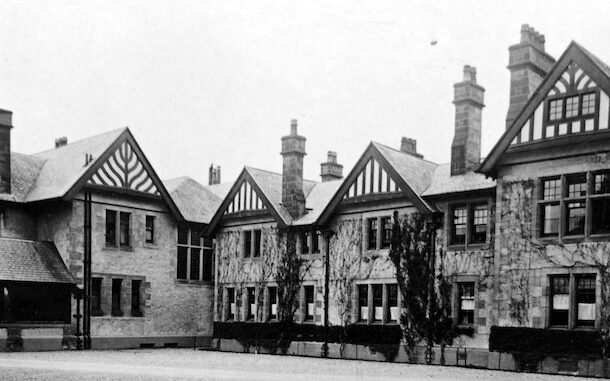

Close

Dungarthill House was built as a wedding present for Albert Edward Cox in the 1880s. Cox belonged to the second generation of a family of jute barons who dominated the economic and political life of Dundee for over a hundred years.
The Cox family had been active in Scotland’s textile industry for generations, perhaps even centuries, before the Industrial Revolution. The business that made the family fortune, the Cox Brothers, incorporated in 1841 when four brothers, each with their own skill to bring to the enterprise, joined forces. James was the charismatic salesman; William, the textile expert; Thomas, the financial guru; and George, the engineer who custom-designed the machinery that would power the family’s factories. Years before other textile manufacturers, they realized the economic potential of jute, a tough natural fiber grown in Bengal. Although it is brittle and difficult to weave, Cox Brothers recognized that it had economic potential because it is cheap, bulky, and strong. When the Crimean War cut off Britain’s access to Russian flax, jute became the packing material of choice and the brothers’ profits soared.
In 1841, Cox Brothers began to construct Camperdown Works to manufacture raw jute into fabric. With time, the sprawling industrial complex employed 5,000 hands and included several factories each with hundreds of massive steam-powered looms, its own railway branch, a foundry to forge the custom parts George Cox designed for the machinery, stables, a fire station, and a half-time school. Burlap sacks and other jute packs manufactured in Dundee would carry the world’s goods across oceans as global trade accelerated in the 19th century. Tightly woven burlap sacks are also tough enough to stop bullets, and so wars sparked economic booms in Dundee. In the wake of the American Civil War, the Cox family used some of their ample profits to build an ornate, Italianate chimney towering 280 feet above the factory to channel the smoke of 28 boilers. It became as much of a symbol of the city as the Eiffel Tower is of Paris.
Each of the Cox brothers who founded the company lived in a grand home just off the factory campus. James’ house, Clement Park House, is the only one still standing. The first generation of jute barons were enormously wealthy in a poor city, but they were still part of the local fabric of Dundee. They preferred to live in the city where they had grown up and where they could supervise their business directly. As local historian James Mair wrote, they were still “local lads made good,” and Dundee was proud of them. Their children, and their children’s children, however, grew up immersed in wealth, went to prestigious schools with the British aristocracy, and became increasingly alienated from the working class that fueled their business. They built a succession of luxurious hunting lodges and country mansions, like Dungarthill, in the style of the aristocracy. They employed decadent private railway cars to reach their rural retreats where they could shoot and fish far away from the grimy city. Soon, few members of the Cox family lived in Dundee at all, preferring Kensington and the company of heiresses to the city filthy with the pollution of their factories.
The jute industry made Dundee a “Women’s Town.” Women’s smaller fingers could more deftly thread machinery. Before mechanization, men had dominated the textile industry, but many refused to work with cheap, mass-produced fabrics out of artisanal pride. Factory owners could also more easily manage and restrict women, and with fewer options, female workers demanded lower wages than their male counterparts. As the jute industry came to define Dundee, women outnumbered men 3-2 and made up 43% of the city’s workforce, which was extremely unusual in Victorian Britain. The women of Dundee, many of them Irish immigrants, earned a reputation for toughness and grit and faced the prejudices of a society hostile to women working outside the home.“The mill girls of Dundee are, to put it mildly, a caution. During the meal hours when passing along they carry all before them. Woe betide that unfortunate wight who attempts to dispute their right to the whole street!” wrote a journalist for the Aberdeen People’s Journal in 1902
Even married women worked, which was especially unusual in the period. With their households dependent on their wages, they often worked right up until they gave birth and could not afford to take the time off after their pregnancy to recover or nurse their babies who instead ate a gruel of bread and water that lacked many essential nutrients. In a time of high infant mortality, Dundee’s infants died at an unusually high rate. While women took on the unusual role of breadwinners, their husbands tended to the kettle and the children, earning the derisive nickname “kettle bilers.”
In the late 19th century and early 20th century, Dundee became a bastion of the sufragette and temperance movements. When jute workers started their most important union, its articles required that women fill at least half of the leadership positions. Still, despite the economic empowerment of women in Dundee, their lack of other labor opportunities allowed the factory owners to offer wages far lower than those in other factory towns. Men occupied all management positions except the position of” shift mistress,” who oversaw young child workers. Factory owners believed that women needed to be closely surveilled by male supervisors. Weavers were better paid and lived in respectable conditions, but spinners earned poverty wages and crammed into small apartments rife with disease. Dundee did not have an adequate supply of clean water until 1876, and epidemics of cholera and typhus consumed the city, pushing down the life expectancy for men to 33.
Despite the vast inequality between the working poor and the jute barons, families like the Coxes still enjoyed some popularity in 19th-century Dundee. When Britain expanded the franchise to include more of the working class, jute barons won more seats in Dundee’s town council. The factories organized recitations, soirées, and escapades to St. Andrews. These symbolic celebrations did not improve the quality of life in Dundee, but they smoothed over relations between the jute barons and the working class.
The connection between the jute barons and the working class eroded with time. The jute industry in Dundee declined as Indian factories took over the market, and the Cox family transitioned from manufacturing jute to managing the enormous capital they had built over decades of production. Their money helped open up the American West, funding the cattle ranches and railroad companies that integrated the frontier into the American economy.
In 1912, relations between the Cox family and their workers reached a crisis point. Workers at Camperdown Works were making no more than their grandparents had made in the 1840s and they were desperate. 2,000 striking workers marched to the Royal Exchange in central Dundee and then to the head office of the Cox Brothers. The seething crowd of angry, impoverished workers terrified the Cox family so much that they ordered 16 .38 caliber automatic pistols and 1500 rounds of ammunition from Harrods in London using a game license. The stage was set for bloody mayhem. But then the union ran out of the funds it needed to keep workers from starving without their pay, and it called off the strike.
Although World War I briefly revived Dundee’s jute industry, it faded in the 20th century. Camperdown Works was the last of the jute factories to close, although the Cox chimney remains a defining urban symbol of Dundee. The city’s economy never recovered. In 1988, the BBC chose the empty factories of Dundee to stand in for a bombed-out Berlin in its television drama Christabel.
Sources:
– Dundee Heritage Trust Online Collections
– “A Family Empire” by James Mair
– “Dundee’s Jute Mills and Factories” by Emma Wainwright
– Victorian Dundee: Images and Realities by Christopher A. Whatley
– Verdant Works, a museum that tells the story of Dundee’s industrial textile heritage